2023 Premier’s Anzac Student Tour
2023 Premier’s Anzac Student Tour
The Premier’s Anzac Student Tour travelled to Sydney and New Zealand in April 2023.
Accompanied by 3 teachers, the group of students departed for the 10-day tour on 16 April 2023.
The unique 2023 program gave students an opportunity to investigate the Anzac legacy and commemorate those who served in the armed forces, and the 78th anniversary of the end of the Second World War.
Students from across Western Australia submitted their entries for the chance to be selected as ambassadors for the tour. Ten students from 10 different schools were selected to share in the experience. They will attend a briefing session ahead of undertaking their historical study tour.
- Tour diary, Day 10: Anzac Day
- Tour diary, Day 9: Stony Batter
- Tour diary, Day 8: Te Hana Te Ao Marama
- Tour diary, Day 7: Auckland
- Tour diary, Day 6: Sydney to Auckland
- Tour diary, Day 5: Cockatoo Island
- Tour diary, Day 4: Sydney
- Tour diary, Day 3: A busy day in Sydney
- Tour diary, Day 2: Deep contemplation
- Tour diary, Day 1: Arrival
- Tour participants
- Student entries
Tour diary, Day 10: Anzac Day
By Elizaveta Fedotova, Year 9, Bob Hawke College
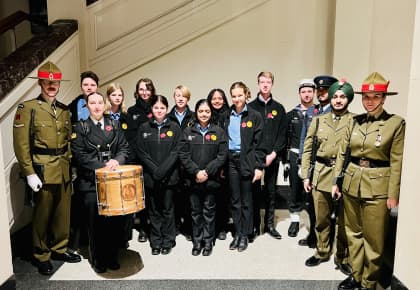 The very last day of our tour brought mixed emotions within me. I was glad to be finally seeing my family after being away for 10 days, but I was also devastated that I would be leaving behind my friends that I had gotten so close to, and I would miss the experiences that would leave us exhausted but thrilled at the end of each day.
The very last day of our tour brought mixed emotions within me. I was glad to be finally seeing my family after being away for 10 days, but I was also devastated that I would be leaving behind my friends that I had gotten so close to, and I would miss the experiences that would leave us exhausted but thrilled at the end of each day.
We started this day by attending the dawn service at the Auckland War Memorial. Although we had to wake up at 3 in the morning, this was an experience not to be forgotten. As we stood looking at the cenotaph and our hands turned blue from the cold, I truly reflected on the great sacrifices that the ANZAC troupes would have made. I looked at the veterans, who had survived the war, and I did not see sorrow or despair. What I saw in their faces was pride for their nation and their culture. Losing a close friend and fellow soldier is unimaginably hard, but their sacrifices have shaped our nation, our culture, our identity as Australians and New Zealanders and everything that we believe and honour. This is true Anzac spirit and passing on the legacy of such great men and women is a real honour.
This thoughtful ceremony brought me some inspiration.
Anzac Day is not
a day to be celebrated
But a day where the fearless heroes
are remembered and commemorated
They risked their lives for us
For the kids, for the land Down Under
They fought for peace and love the world
Human life was the price to clear that thunder
We stand tall in respects
Service at dawn, sound of cornet
The ones who didn’t return
We won’t ever forget
Anzac Day is not
a day to be celebrated
But a day where the fearless heroes
are remembered and commemorated.
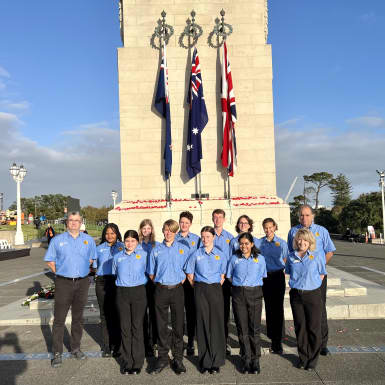 Similarly, when later on during the day, we visited the local RSA (Returned Service Association) for a very meaningful service, it was a very reflective moment for me. When we walked into the pavilion, I was amazed at the amount of people that had arrived. It shows how much the community supports one another and are ready to step up to the opportunity if it becomes necessary. Whilst talking to the local cadets, I learnt that these people are ready for anything that comes their way and are ready to martyr themselves for the greater good.
Similarly, when later on during the day, we visited the local RSA (Returned Service Association) for a very meaningful service, it was a very reflective moment for me. When we walked into the pavilion, I was amazed at the amount of people that had arrived. It shows how much the community supports one another and are ready to step up to the opportunity if it becomes necessary. Whilst talking to the local cadets, I learnt that these people are ready for anything that comes their way and are ready to martyr themselves for the greater good.
After our time at the RSA, we visited the graves of New Zealand fallen soldiers. It was a very emotional experience to see relatives visiting their soldiers. All of these soldiers were some mother’s son and possibly could have been a child’s father. It seems unfair that they should be deprived of this opportunity to have a family. As we looked at the headstones, I noticed that most men had not even reached the age of 40, some even under the age of 25. I can’t even begin to imagine what it would be like to lose my father or brother and really commend those who did this and kept going on with life. It is truly something that should be honoured and respected.
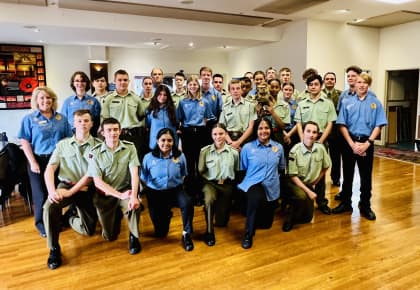 Throughout the tour, I have learnt and experienced so many new things I wouldn’t even know where to start. I learnt about the efforts on the Homefront, the battlefield, defence and plotting systems, but most importantly, I have learnt what the Anzac spirit truly is and what it means to uphold the legacy of the soldiers who gave up everything in favour of their country and community. All in all, the PAST has left me exhausted but has been an amazing experience and although I am very disappointed that the tour is over, as wisely quoted in the book of Felicity, “The end of a journey means the start of another one”.
Throughout the tour, I have learnt and experienced so many new things I wouldn’t even know where to start. I learnt about the efforts on the Homefront, the battlefield, defence and plotting systems, but most importantly, I have learnt what the Anzac spirit truly is and what it means to uphold the legacy of the soldiers who gave up everything in favour of their country and community. All in all, the PAST has left me exhausted but has been an amazing experience and although I am very disappointed that the tour is over, as wisely quoted in the book of Felicity, “The end of a journey means the start of another one”.
Tour diary, Day 9: Stony Batter
By Rishita Sarkar, Year 12, Perth Modern School
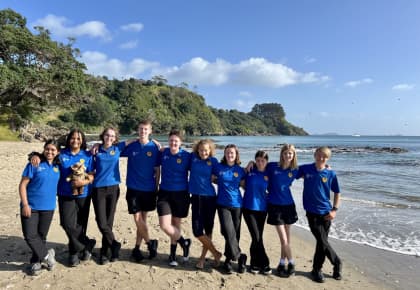 I woke up this morning expecting today’s experience on Waiheke Island to be a treatise on Stony Batter’s role in New Zealand’s defence system, and while it was, it was also so much more than that: it was an engaging history lesson, an insight into the beautiful landscape of New Zealand, and for many of us, a burst of inspiration to work towards our dreams, no matter how big they are.
I woke up this morning expecting today’s experience on Waiheke Island to be a treatise on Stony Batter’s role in New Zealand’s defence system, and while it was, it was also so much more than that: it was an engaging history lesson, an insight into the beautiful landscape of New Zealand, and for many of us, a burst of inspiration to work towards our dreams, no matter how big they are.
We embarked from our landing place on the more touristy western side of Waiheke Island with our cheerful bus driver Dean and struck our way out across the island towards Stony Batter, invigorated from the wild and windy ferry ride across from Auckland.
Along the way we were surrounded by a picturesque landscape of rolling green fields and dazzling blue ocean – today was our first day in New Zealand where the sun deigned to finally show its face, and the weather couldn’t have been better.
Stony Batter seems to be a bit of a hidden gem in the tapestry of New Zealand’s history – though perhaps this is just a bit of a blind spot of mine as an Australian – but in recent times it has been recognised as a Category One Heritage Site, as well as being designated the title of one of two national treasures in Auckland. Having been commissioned in the Second World War in response to Japan, the end of the war came soon after it was finally completed and it was decommissioned during the 1950s.
 It felt like some sort of poetic cyclicality to find out that upon decommission, the steel from the site actually went to Japan to aid in its economic recovery, before returning after being processed there to build Auckland’s Harbour Bridge. It’s amazing how the relationships between two countries can change in times of war and peace.
It felt like some sort of poetic cyclicality to find out that upon decommission, the steel from the site actually went to Japan to aid in its economic recovery, before returning after being processed there to build Auckland’s Harbour Bridge. It’s amazing how the relationships between two countries can change in times of war and peace.
It was interesting to see parallels in the setup of Stony Batter with the batteries we’ve visited in places such as the North Fort in Sydney, and we managed to reach a new depth of understanding of the mechanisms of their defence. This is information that in this case seems to be only recently coming to light, given the secrecy that surrounded not only the operation of this battery but also its very construction – all the soil from the tunnelling was collected and transferred elsewhere, and even the Mayor of Auckland at the time purportedly didn’t know about it! The 1,200 metres of tunnel with thirteen chambers were carved entirely by hand, and the workers were not able to leave or write to family until construction was completed three and a half years later. The tunnels are something of a technological and construction marvel with their sheer scale and self-regulation in terms of ventilation and water.
I particularly enjoyed being able to learn more about the role of women and technology in the Plotting Room. Our tour guide and archaeological project director Timothy Moon went into detail about the capabilities of the radar stations, which could detect ships from 300 kilometres away, as well as the observation stations, which were coupled with a range of other defensive measures such as seabed coils and underwater mines to protect Auckland Harbour from enemy ships and submarines. This detective technology was used by seven women working in the Plotting Room to calculate the trajectory and path at which to aim at enemy ships, though the guns at Stony Batter were never shot in anger. The development of this defence system was prompted by Japanese submarines surveying the Auckland and Wellington Harbours, subsequently going forward to bomb the Sydney Harbour.
Another event of note that we learnt about was the sinking of the RMS Niagara – considered to be the most luxurious ocean liner of the time – by underwater mines placed off the coast of New Zealand by German raider Orion. While everyone survived, the ship was carrying a top-secret cargo of gold bullion, some of which still remain beneath the ocean’s surface. It was a little bit awe-inspiring to hear of Tim’s plans to coordinate the recovery of this gold for the New Zealand government and remove the oil present within the ship, as well as his idea of creating a time capsule instructed to be opened in 2273 – two hundred and fifty years from now! His fascinating ideas and depth of historical knowledge were captivating and inspired us to further our own knowledge and work towards our own dreams, no matter what it may take to achieve them.
On the second to last day of the Premier’s Anzac Student Tour, I look back at how visiting these amazing locations have helped deepen my love for learning even further, and I hope to be able to take not only the knowledge I have gained but also the passion that has continued to grow on this tour and spread it to the youth in my community. As we go to sleep in preparation to wake up for the Dawn Service tomorrow, I feel honoured to be able to commemorate the Anzac legacy with my fellow ambassadors and hope to continue this experience of lifelong learning.
Tour diary, Day 8: Te Hana Te Ao Marama
By Adoley Mensah, Year 9, Wyndham District High School
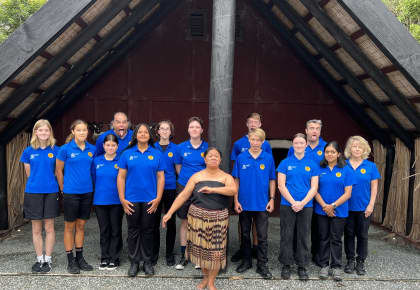 On day 8 of the Anzac Student Tour, we embarked on an hour-long bus ride to Te Hana Te Ao Marama Marae where we were greeted by our wonderful tour guide Mereana. We were welcomed into the Marae House, and after a briefing on what we were going to see, we made our way into the heart of the village via a wooden walkway surrounded by native plants, medicines, and fresh water. The village was set up in the way the ancient villages would have been, and everything felt authentic. A horn was played as we were getting closer to the actual village, which was what would happen in the ancient days when visitors were entering a village.
On day 8 of the Anzac Student Tour, we embarked on an hour-long bus ride to Te Hana Te Ao Marama Marae where we were greeted by our wonderful tour guide Mereana. We were welcomed into the Marae House, and after a briefing on what we were going to see, we made our way into the heart of the village via a wooden walkway surrounded by native plants, medicines, and fresh water. The village was set up in the way the ancient villages would have been, and everything felt authentic. A horn was played as we were getting closer to the actual village, which was what would happen in the ancient days when visitors were entering a village.
Once inside, a powhiri was performed welcoming us, followed by dances that were emotional and beautiful. We watched as the performers used a Poi Poi, which is a ball on the end of a rope that is bounced on the user's arms and swung around in a complicated fashion. The Poi Poi's original use was for men to strengthen their wrists so they could use weapons better with a lower risk of getting hurt, but nowadays women have taken use of the Poi Poi as well, using it for dance. The Haka was also performed, which was beyond words.
The Marae house had a small door, which we were told was to keep the cold air out and warm air in, to make each person bow to enter and to give the person inside the hut an upper hand if an enemy or intruder was trying to enter. After the Powhiri ceremony was complete, we exited the Marae house, and Mereana's daughter gave us a tour of the village. The layout was interesting, with a section for women and a section for men. The younger boys would stay with their mothers till the age of about twelve, and the girls would stay with their mothers in the women's section.
We then headed out toward the back of the village where there was a statue representing the sad love story of Tihana and Rangikahui, who fell in love at first sight but could not be together as Tihana was betrothed. This story was fascinating and very emotional.
After the tour, we were treated to a festive lunch, where Poppy was sung 'Happy Birthday' in Maori and English for her 15th rotation around the sun. Our French bus driver then took us on a scenic tour of Warkworth and the murky Mahurangi River, and from there to Whangaparaoa Bay. The scenery at low tide was breathtaking. Returning to Auckland, we had an enjoyable walk down the quay and a delicious pizza dinner.
What an amazing day we had! I am still in awe of the deep cultural learning of today and the gained understanding of the differences between the Australian Aboriginal and the New Zealand Maori societies. I am so grateful to have the opportunity of this amazing on-tour learning experience.
Tour diary, Day 7: Auckland
By Harry Forman, Year 11, Katanning Senior High School
 On day 7, we embarked on our first full day in New Zealand, visiting the Torpedo Bay Naval Museum in Devonport and the Auckland War Memorial Museum.
On day 7, we embarked on our first full day in New Zealand, visiting the Torpedo Bay Naval Museum in Devonport and the Auckland War Memorial Museum.
The Torpedo Bay Naval Museum was an exceptional experience, with our knowledgeable tour guide Andrew, who has a master's degree in history, providing insights into the world wars. I learned new information about the events of the world wars, including The Battle of Jutland, the most extensive naval battle in the First World War, which began when the Germans attempted to catch the British fleet off guard. I was also fascinated to learn about the Piupiu, a grass skirt supposedly gifted to the HMS New Zealand by a Maori chief. It was first worn by Captain Halsey during the battle of Heligoland Bite, where the legend of its protection started. The sailors believed it was a lucky charm as there was no damage done to the ship in that battle. This is a prime example of legend building and the positive effect it had on the morale of the sailors and people of New Zealand. It gave hope in a bleak time and provided a Maori connection to the war effort.
 We then travelled by taxi to the Auckland War Memorial Museum, a colossal museum that occupied the entire second floor with remembrance halls for the First and Second World Wars. The museum featured recreations of the Zero and the Spitfire planes, which were significant in the First World War and Second World War, respectively. I found the mystery of the flags in the First World War Sanctuary display intriguing, and the trade routes to New Zealand's map informative. As I examined the flags, I noticed that there was no Australian flag, which prompted me to research further. I discovered that the flags displayed were a recreation of the original Sanctuary room flags from 1929. I also enjoyed studying the map of the trade routes to New Zealand and tried to determine when the map was made by looking at what countries had formed or dissolved. Eventually, I narrowed down the map’s date to between 1871 and 1891.
We then travelled by taxi to the Auckland War Memorial Museum, a colossal museum that occupied the entire second floor with remembrance halls for the First and Second World Wars. The museum featured recreations of the Zero and the Spitfire planes, which were significant in the First World War and Second World War, respectively. I found the mystery of the flags in the First World War Sanctuary display intriguing, and the trade routes to New Zealand's map informative. As I examined the flags, I noticed that there was no Australian flag, which prompted me to research further. I discovered that the flags displayed were a recreation of the original Sanctuary room flags from 1929. I also enjoyed studying the map of the trade routes to New Zealand and tried to determine when the map was made by looking at what countries had formed or dissolved. Eventually, I narrowed down the map’s date to between 1871 and 1891.
We ended the day on a high note, with the rain subsiding, and the anticipation of the cultural activities planned for the following day. I felt proud and honoured to represent the youth of Western Australia when I stood on the steps of the war memorial for a photo shoot. I am eagerly awaiting Anzac Day when thousands of other people will commemorate the legacy of the Anzac alongside me.
Tour diary, Day 6: Sydney to Auckland
By Georgia Kikiros, Year 11, St Andrew's Grammar
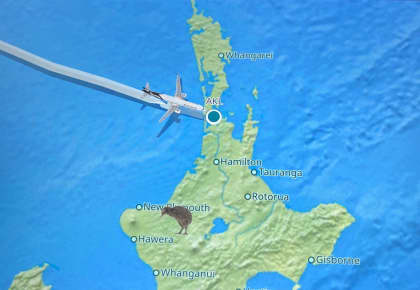 Today marked the first day of our New Zealand trip. We rose before the sun, tidied our rooms, packed our bags and all headed off to the second part of this wonderful journey.
Today marked the first day of our New Zealand trip. We rose before the sun, tidied our rooms, packed our bags and all headed off to the second part of this wonderful journey.
After another delayed flight, we could finally start our three hour adventure to our next destination. One stressful customs and border security check later, we all got out safely and took a scenic bus ride to the hotel.
Unfortunately, the rain put a stop to our walking tour of the harbour.
After reflecting on the day, I marvelled at the rare opportunity we have been given to expand our knowledge on the many conflicts from the perspective of the New Zealand soldiers who fought alongside the Australians. I have also realised the strong bonds I have forged on this trip, and we are all excited to learn new things from one another in the second half of this tour.
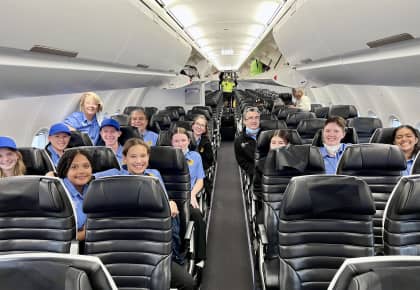 The first half of this tour consisted of tours around Sydney including the Anzac Memorial in Hyde Park, Sydney Jewish Museum, Middle Head, North Fort, Cockatoo Island and last but certainly not least, the Hyde Park Barracks which many of us including myself felt very connected to.
The first half of this tour consisted of tours around Sydney including the Anzac Memorial in Hyde Park, Sydney Jewish Museum, Middle Head, North Fort, Cockatoo Island and last but certainly not least, the Hyde Park Barracks which many of us including myself felt very connected to.
Each of these destinations engaged us in various forms of learning, including an independent audio tour as well as group-guided tours. It helped us to develop a deeper understanding of the history and legacy of the Anzac legend.
Tour diary, Day 5: Cockatoo Island
By Zoe Stockdale, Year 11, Eastern Goldfields College
Day five consisted of a very rainy tour around Cockatoo Island followed by a vivid interactive experience at Hyde Park Barracks.
 After an unexpectedly long ferry ride, we arrived early at Cockatoo Island. Since we had some extra time, we did a pre-tour ourselves, walking around some of the island where it rained on us several times. Our tour guide John led us around the island on the Second World War and Shipyard tour, where we learnt about the shipyards being used for assembling and repairing ships, particularly during war periods. On the Convict Precinct tour, also led by John, we were able to view the convict barracks and learnt that the island was settled as a penal colony due to its large supply of sandstone. An interesting fact from this tour was that the first New South Whales' police force consisted of ex-convicts.
After an unexpectedly long ferry ride, we arrived early at Cockatoo Island. Since we had some extra time, we did a pre-tour ourselves, walking around some of the island where it rained on us several times. Our tour guide John led us around the island on the Second World War and Shipyard tour, where we learnt about the shipyards being used for assembling and repairing ships, particularly during war periods. On the Convict Precinct tour, also led by John, we were able to view the convict barracks and learnt that the island was settled as a penal colony due to its large supply of sandstone. An interesting fact from this tour was that the first New South Whales' police force consisted of ex-convicts.
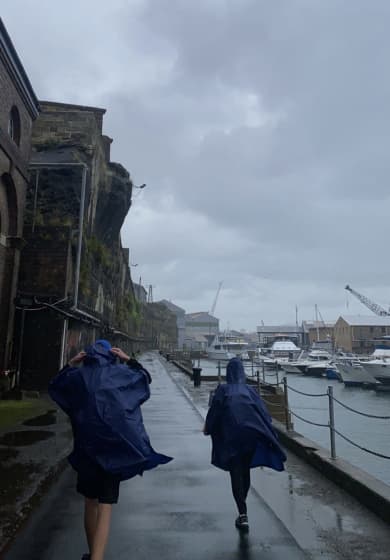 We then travelled to Hyde Park Barracks partly by ferry, which was unfortunately our last ferry ride of the Sydney leg of our tour. An interactive audio tour guided us around the Barracks, containing information about the origins of the building and its uses in developing colonial Sydney. The barracks opened in 1819 as housing for male convicts and was a result of Governor Macquarie’s belief that convicts should be reformed and reintegrated into society. By 1848, when the industry was booming in Sydney, the barracks no longer housed convicts, instead it housed immigrant women up until 1887. This was primarily shown in the tour through the exhibits of the clothes they wore, the conditions, and the various personal stories playing through the audio tour. Another of the exhibits, relating to the convicts, told us of the Blacktown Native Institution built by convicts from Hyde Park Barracks, opened in 1823, and how it was a government attempt to control First Nations people, contributing to later government policies pulling these children from their homes. The recognition of the barracks’ role in the massacres of the First Nations people and the way in which the convicts were treated, illustrated through the exhibits, helped us to reflect on the pain and suffering of both the convicts and first nations and people and how, though things have altered in a positive way, there’s still a long way to go in terms of reconciliation.
We then travelled to Hyde Park Barracks partly by ferry, which was unfortunately our last ferry ride of the Sydney leg of our tour. An interactive audio tour guided us around the Barracks, containing information about the origins of the building and its uses in developing colonial Sydney. The barracks opened in 1819 as housing for male convicts and was a result of Governor Macquarie’s belief that convicts should be reformed and reintegrated into society. By 1848, when the industry was booming in Sydney, the barracks no longer housed convicts, instead it housed immigrant women up until 1887. This was primarily shown in the tour through the exhibits of the clothes they wore, the conditions, and the various personal stories playing through the audio tour. Another of the exhibits, relating to the convicts, told us of the Blacktown Native Institution built by convicts from Hyde Park Barracks, opened in 1823, and how it was a government attempt to control First Nations people, contributing to later government policies pulling these children from their homes. The recognition of the barracks’ role in the massacres of the First Nations people and the way in which the convicts were treated, illustrated through the exhibits, helped us to reflect on the pain and suffering of both the convicts and first nations and people and how, though things have altered in a positive way, there’s still a long way to go in terms of reconciliation.
Our time in Sydney has been full of learning and has inspired me to expand my knowledge even further on the Anzac legacy. See you in Auckland!
Tour diary, Day 4: Sydney
By Joshua Patrick, Year 10, Northam Senior High School
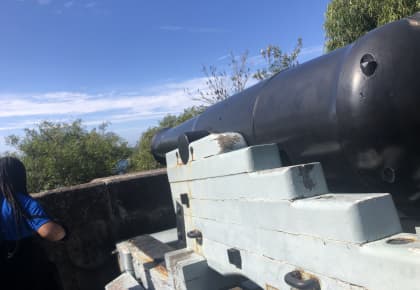 Today the tour went to multiple places regarding the coastal defence of Sydney Harbour. From the original Australian colonial times to the end of the Second World War we were able to see guns, artillery batteries and even strategically manned and crafted tunnels and forts specifically designed to withstand blasts from interior errors (like the explosion of an ammunitions room) to exterior bombardment from ships, all while supplying the guns with the necessary ammunition to continue the massive cannon’s operation.
Today the tour went to multiple places regarding the coastal defence of Sydney Harbour. From the original Australian colonial times to the end of the Second World War we were able to see guns, artillery batteries and even strategically manned and crafted tunnels and forts specifically designed to withstand blasts from interior errors (like the explosion of an ammunitions room) to exterior bombardment from ships, all while supplying the guns with the necessary ammunition to continue the massive cannon’s operation.
The day began with a tour of the Middle Head early colonial batteries (cannons) and living quarters, where we were greeted by ex-military personnel tour guide Ian Rushden. With this, said Ian, we somewhat travelled back through time in a reverse-chronological order going through the buildings that came to be wards, wards that were one of the first to test the idea of massage on critically (and supposed permanently) injured soldiers. Most importantly we had the privilege to see the colonial guns that defended the harbour in a time of relative peace. To my surprise, these guns were the base design of comical cannons in cartoons and even initiated the saying 'pull your finger out', in reference to a soldier pulling their finger out of the fuse hole.
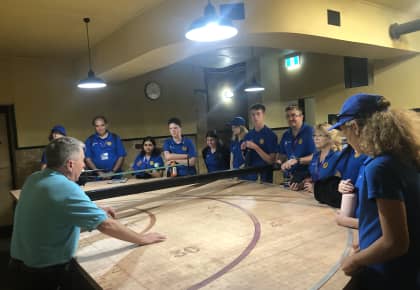 After the first tour of the day the group travelled over to another set of guns (located at North Port) set up during the time of the Second World War and the Sydney attack. The best part of the second tour was the plotting room where the actual angle and distance were calculated. The math done in this plotting room was extraordinary, just to name a few variables to figure out through the gunfight were wind speed, distance, bearing, speed of the vessel and even the time it took for the round to be propelled beyond the horizon. However, the most extraordinary part of this and unfortunately untold part of this is that it was manned by women that were great mathematicians and multi-taskers. But the reason this story of female heroes was due to the great secrecy of the time with these installations to ensure the location is not compromised. In total, I really enjoyed today as it finished many partly known stories and clarified a lot of the technology and social advancements they had at the time.
After the first tour of the day the group travelled over to another set of guns (located at North Port) set up during the time of the Second World War and the Sydney attack. The best part of the second tour was the plotting room where the actual angle and distance were calculated. The math done in this plotting room was extraordinary, just to name a few variables to figure out through the gunfight were wind speed, distance, bearing, speed of the vessel and even the time it took for the round to be propelled beyond the horizon. However, the most extraordinary part of this and unfortunately untold part of this is that it was manned by women that were great mathematicians and multi-taskers. But the reason this story of female heroes was due to the great secrecy of the time with these installations to ensure the location is not compromised. In total, I really enjoyed today as it finished many partly known stories and clarified a lot of the technology and social advancements they had at the time.
Tour diary, Day 3: A busy day in Sydney
By Alex Wenzel, Year 11, Great Southern Grammar
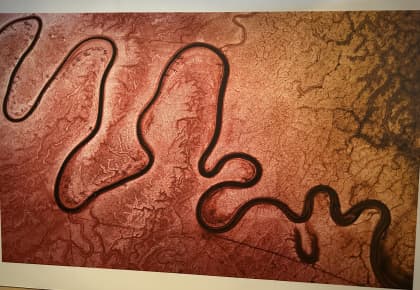 I cannot believe it's day three of the tour already! Today was another jam-packed day, where we visited the heritage centre at Garden Island Navy Precinct and the Australian Museum. We also walked through the botanical garden and visited the iconic Sydney Opera House up close as the sun set – a calming finish to a very busy day.
I cannot believe it's day three of the tour already! Today was another jam-packed day, where we visited the heritage centre at Garden Island Navy Precinct and the Australian Museum. We also walked through the botanical garden and visited the iconic Sydney Opera House up close as the sun set – a calming finish to a very busy day.
As we bussed to Garden Island, we were met with a parade of gigantic steel-grey warships lining the island, which we later learned the roles of, including two square-ended carrier vessels designed to house and land/launch helicopters and ships. We were guided around the heritage museum by Warrant Officers, Hugh Johnson and Chris Perrin, who were happy to answer all our questions. Inside the museum, there was a replica bridge from the Second World War Navy vessels, which included an amazing phone system powered by sound, to be used when electricity is not available. They also had, which was greatly anticipated, the mid-section of one of the midget submarines used by the Japanese to infiltrate Sydney Harbour during the Second World War. This was an amazing piece to see first-hand, after hearing so much about the attack, it was incredible to see it in person and to have our understanding deepened of what it would have been like, not just for the Australians but for the Japanese during the attack.
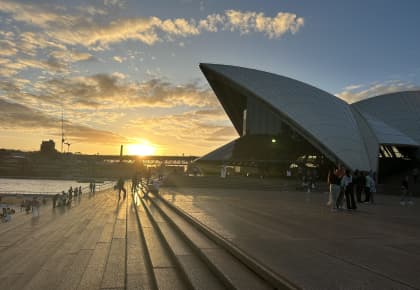 After lunch at Hyde Park, we walked over to the Australian Museum. Viewing ‘Barka: The Forgotten River’ exhibit was an eye-opening experience, with a story that told of Barkandji community who live on the river, and how the terrible condition the river is in affects them and their community. For a story that many of us may not have heard of, let alone know the details of. The exhibition, which included paintings, photographs and audio, illustrated the dire situation the community is in, and the importance of preserving and caring for the environment. And though we went to the Australian Museum for the Barka exhibit, we also got the opportunity to visit some of the other exhibits, including 200 treasures where there was a prehistoric opalised fossil of Cretaceous period pliosaur ‘Eric’, who was found in Coober Pedy, South Australia.
After lunch at Hyde Park, we walked over to the Australian Museum. Viewing ‘Barka: The Forgotten River’ exhibit was an eye-opening experience, with a story that told of Barkandji community who live on the river, and how the terrible condition the river is in affects them and their community. For a story that many of us may not have heard of, let alone know the details of. The exhibition, which included paintings, photographs and audio, illustrated the dire situation the community is in, and the importance of preserving and caring for the environment. And though we went to the Australian Museum for the Barka exhibit, we also got the opportunity to visit some of the other exhibits, including 200 treasures where there was a prehistoric opalised fossil of Cretaceous period pliosaur ‘Eric’, who was found in Coober Pedy, South Australia.
As we walked through the Royal Botanic Garden, we paused at the gates to the stately Government House, another beautiful gothic building from the 19th century that Sydney has preserved. The pot of gold at the end of the rainbow of our walk was the iconic, awe-inspiring Opera House. This of course inspired many, many photos and was a lovely way to finish off our third day of the Premier’s Anzac Student Tour 2023.
Tour diary, Day 2: Deep contemplation
By Poppy Fletcher, Year 10, Mount Lawley Senior High School
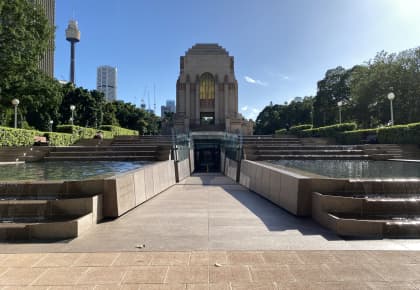 Day 2 of our Anzac tour took us on a thought-provoking journey to the Sydney Anzac Memorial Museum and the Sydney Jewish Museum, where we had the immense privilege of participating in a memorial ceremony and talking to a Holocaust survivor.
Day 2 of our Anzac tour took us on a thought-provoking journey to the Sydney Anzac Memorial Museum and the Sydney Jewish Museum, where we had the immense privilege of participating in a memorial ceremony and talking to a Holocaust survivor.
Our day began with a visit to the Sydney Anzac Memorial Museum, where we watched an exceptionally beautiful performance lifted from the diaries of 3 different nurses and a matron. It followed the stories of Alice Cashin, Evelyn Wright, Muriel Wakeford, and Clementina Marshall. We felt the incorporation of their individual stories was powerful. The acting from Candice, one of our guides was fluid and emotive, and we truly felt that we were there in the action alongside her. It was an incredible spotlight on those who are often looked over in favour of the soldiers in the war, and their efforts must not be forgotten. A depiction of a matron is also found on the outside of the memorial and on the inside of the chamber, alongside two nurses.
Despite our bus being cancelled, we still made it to our second destination, the Sydney Jewish Museum, on time. Our first part of our tour was meeting a Holocaust survivor, named Jack Meister, and hearing his personal story of surviving Auschwitz. His recollection was incredibly moving for all of us, as he recounted the time he spent on the death march from Auschwitz to Buchenwald and after the war when he migrated and settled in Australia. The most important part of his journey for us was his persistence and his cheerful attitude. Despite all the hardships he faced, Jack was still jovial and happy to share his story with us. It was a humbling reminder that this happened to real people, and it was eye-opening to hear this in person from someone who was there and experienced it.
 The second part of our tour was a history of the persecution of Jewish people leading up to the events of the Second World War. Another confronting section of the walk-through was the memorial to all the children that died during the Holocaust. As you walked into the dedicated section we were greeted by the belongings of children and a clay art piece of children’s shoes, meant to represent those of all the child victims. We mourned the lives lost in solemn contemplation.
The second part of our tour was a history of the persecution of Jewish people leading up to the events of the Second World War. Another confronting section of the walk-through was the memorial to all the children that died during the Holocaust. As you walked into the dedicated section we were greeted by the belongings of children and a clay art piece of children’s shoes, meant to represent those of all the child victims. We mourned the lives lost in solemn contemplation.
It was an incredibly powerful day of reflection on the past, but also moving towards the future, in our role of sharing the stories we indulge in on this tour.
Tour diary, Day 1: Arrival
A collective contribution by all student ambassadors
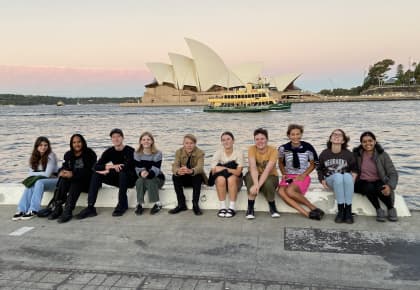 Not only the first, and much anticipated, day of the 2023 Premier’s Anzac Student Tour but also a day of many firsts! For one member of the group, it was the first time in a plane and for many, it was the first time in Sydney. A walk to the magnificent harbour area, surrounded by the majestic Sydney Harbour Bridge and the iconic Sydney Opera House was a great way to start the tour. We had seen these so many times but to see them up close, in person was surreal.
Not only the first, and much anticipated, day of the 2023 Premier’s Anzac Student Tour but also a day of many firsts! For one member of the group, it was the first time in a plane and for many, it was the first time in Sydney. A walk to the magnificent harbour area, surrounded by the majestic Sydney Harbour Bridge and the iconic Sydney Opera House was a great way to start the tour. We had seen these so many times but to see them up close, in person was surreal.
Staying at The Rocks is such a privilege, not only being so close to everything but walking the historic cobbled streets gave us a window to the past. We particularly liked the integration of the old and new architecture, where they have preserved history while making it functional. The acknowledgement of the colonial and convict heritage on plaques throughout The Rocks deepened our understanding of the significance of the area.
Student ambassadors
| Name | Year | School |
|---|---|---|
| Elizaveta Fedotova | 9 | Bob Hawke College |
| Adoley Mensah | 9 | Wyndham District High School |
| Poppy Fletcher | 10 | Mount Lawley Senior High School |
| Joshua Patrick | 10 | Northam Senior High School |
| Harry Forman | 11 | Katanning Senior High School |
| Georgia Kikiros | 11 | St Andrew's Grammar |
| Zoe Stockdale | 11 | Eastern Goldfields College |
| Alex Wenzel | 11 | Great Southern Grammar |
| Rishita Sarkar | 12 | Perth Modern School |
| Ebony Whitney | 12 | Collie Senior High School |
Teacher supervisors
| Name | School |
|---|---|
| Patrick Marzohl | Margaret River Senior High School |
| John Coules | Rossmoyne Senior High School |
Students were selected based on their response to the question:
- In what way might efforts on the home front be seen as important as battles fought overseas?
Applications for the 2023 Premier’s Anzac Student Tour competition closed on Friday 12 August 2022.
More information
Secondary Schools, District High Schools and Post-School Pathways
E: anzactour@education.wa.edu.au
T: 9402 6123